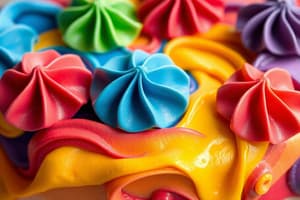Podcast
Questions and Answers
What is required for the exploitation of works created by the Government of the Philippines for profit?
What is required for the exploitation of works created by the Government of the Philippines for profit?
- Prior approval from the government agency or office (correct)
- Payment of a licensing fee only
- Publication in a national newspaper
- A written approval from the President
Who is responsible for ensuring copyright compliance for borrowed materials in the module?
Who is responsible for ensuring copyright compliance for borrowed materials in the module?
- The publisher and authors (correct)
- The Department of Education alone
- The government of the Philippines only
- The students utilizing the module
Which of the following does Republic Act 8293, section 176 specifically mention regarding government works?
Which of the following does Republic Act 8293, section 176 specifically mention regarding government works?
- No accountability is required for borrowed materials
- Government works can be sold without consent
- Royalty payments can be imposed by agencies (correct)
- All works are free to use without restrictions
What is the role of the author in the development team of the module?
What is the role of the author in the development team of the module?
Which of the following responsibilities is NOT assigned to Emma Concepcion S. Reso-or?
Which of the following responsibilities is NOT assigned to Emma Concepcion S. Reso-or?
What is the primary aim of the learning resource mentioned in the module?
What is the primary aim of the learning resource mentioned in the module?
What type of support is expected from the facilitator according to the module?
What type of support is expected from the facilitator according to the module?
Which part of the module provides insight into the skills or competencies to be learned?
Which part of the module provides insight into the skills or competencies to be learned?
What does the 'What I Know' section primarily aim to do?
What does the 'What I Know' section primarily aim to do?
How does the resource intend to accommodate learners' diverse needs?
How does the resource intend to accommodate learners' diverse needs?
Flashcards
Guided and Independent Learning
Guided and Independent Learning
Learning that allows students to learn at their own pace and time, often using digital resources.
Guided Learning
Guided Learning
The learner's journey is guided and supported.
Independent Learning
Independent Learning
The learner is responsible for their learning and works without direct supervision.
21st Century Skills
21st Century Skills
Signup and view all the flashcards
Learners' Needs and Circumstances
Learners' Needs and Circumstances
Signup and view all the flashcards
Decorating and Presenting Cakes Module
Decorating and Presenting Cakes Module
Signup and view all the flashcards
TVL-11 Bread & Pastry Production
TVL-11 Bread & Pastry Production
Signup and view all the flashcards
Alternative Delivery Mode (ADM)
Alternative Delivery Mode (ADM)
Signup and view all the flashcards
Grade 11 – Bread & Pastry Production
Grade 11 – Bread & Pastry Production
Signup and view all the flashcards
First Edition, 2020
First Edition, 2020
Signup and view all the flashcards
Study Notes
TVL-H.E.-Bread & Pastry Production Module 4: Decorating and Presenting Cakes
- This module details aspects of decorating and presenting cakes, part of the TVL-H.E. Bread & Pastry Production curriculum.
- The module is geared towards Grade 11 students.
- The module is designed for both private and public school educators.
- This module provides guided and independent learning, suitable for varied learning styles and paces.
- Information is presented in a user-friendly manner, using icons for different learning components.
- The module emphasizes practical skills and is suitable for various contexts.
- The material is published by the Department of Education.
- Key figures within the Department of Education are mentioned.
- The module includes a "Notes to the Teacher" section providing guidance for facilitators.
- The "What I Need to Know" section introduces the skills and competencies to be learned.
- The "What I Know" section assesses pre-existing knowledge.
- The "What's In" section reviews prior learning.
- The "What's New" section introduces new concepts.
- The "What Is It" section delves into the concepts.
- The "What's More" section encourages independent practice.
- The "What I Have Learned" section summarizes key learning points.
- The "What I Can Do" section gives activities to apply learning.
- An assessment section is included for evaluating mastery.
- Additional activities can be carried out upon mastering the fundamental skills introduced within the module.
Different Types of Icing
- Buttercream: A versatile icing made from powdered sugar, milk, and superior butter. Quality of butter affects taste and appearance.
- Whipped Cream: A light and airy icing made with heavy whipping cream and sugar.
- Royal Icing: A hard, decorative icing using egg whites and powdered sugar.
- Cream Cheese Frosting: A smooth icing using cream cheese and butter cream, suited for varied types of cakes.
- Meringue: A light and fluffy icing made from egg whites, water, and granulated sugar, commonly used for decorated cakes.
- Fondant: A smooth, hard icing used for decorative purposes on cakes.
- Chocolate Ganache: A rich and flavorful icing made from chocolate and cream.
Procedure for Icing a Cake
- Steps are outlined for preparing the cake surface for icing.
- Instructions for positioning icing, layer placement, and filling.
- Techniques for achieving smooth and even finishes on the cake.
- Tips and tricks on handling icing are mentioned, along with directions for the type of tools required.
Studying That Suits You
Use AI to generate personalized quizzes and flashcards to suit your learning preferences.




